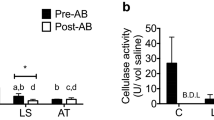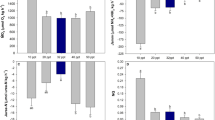Abstract
The effects of salinity variation on organic solute accumulation have been studied in marine Enteromorpha intestinalis (L.) Link (St. Andrews, Fife, National Grid Ref. NO 514168, and Fife Ness, Fife, National Grid Ref. NO 638098) collected from upper mid-shore rock pools from January to July 1987; and in freshwater E. intestinalis (Forfar Loch, Angus, National Grid Ref. NO 440504) collected during August 1986, in short-term (48 h) and long-term (35 d) experiments. The tertiary sulphonium compound β-dimethylsulphoniopropionate (DMSP) was the principal organic osmolyte in unstressed cells; marine plants contained greater amounts of DMSP than freshwater plants. Exposure to increased salinity resulted in the short-term accumulation of proline and sucrose, while DMSP was unchanged in freshwater and marine plants. In longer-term exposure to salt stress, sucrose levels declined while DMSP increased and proline levels remained high. Long-term incubation in hypersaline media increased the tissue protein and chlorophyll levels of marine E. intestinalis; this may be linked to changes in the cytoplasm:vacuole ratio of the cell. Prolonged exposure to hyposaline and hypersaline conditions led to changes in DMSP content in the manner predicted for an osmotic effector, suggesting that DMSP is involved in long-term osmoacclimation in Enteromorpha spp. The results are also consistent with the proposal that DMSP acts as a compatible cytosolute in Enteromorpha species.
Similar content being viewed by others
Literature cited
Bates, L. S., Waldren, R. P., Teare, I. D. (1973). Rapid determination of free proline for water stress studies. Pl. Soil 39: 205–207
Ben-Amotz, A., Avron, M. (1983). Accumulation of metabolites by holotolerant algae and its industrial potential. A. Rev. Microbiol. 17: 95–119
Black, D. R. (1971). Ionic relationships of Enteromorpha intestinalis (L.) Link. Ph.D. thesis, University of St. Andrews
Black, D. R., Weeks, D. C. (1972) Ionic relationships of Enteromorpha intestinalis. New Phytol. 71: 119–127
Bliding, C. (1963). A critical survey of European taxa in Ulvales. Part I. Capsosiphon, Percursaria, Blidingia, Enteromorpha. Op. bot. Soc. bot. Lund. 8: 1–160
Bradford, M. M. (1976). A rapid and sensitive method for the quantification of microgram quantities of protein using the principle of protein-dye binding. Analyt. Biochem. 72: 248–254
Brown, A. D., Simpson, J. R. (1972). Water relations of sugartolerant yeasts: the role of intracellular polyols. J. gen. Microbiol. 72: 589–591
Challenger, F., Baywood, R., Thomas, P., Haywood, B. J. (1957). Studies on biological methylation. XVIII. The natural occurrence and chemical reactions of some thetins. Archs Biochem. Biophys. 69: 514–523
Davison, I. R., Reed, R. H. (1985). The physiological significance of mannitol accumulation in brown algae: the role of mannitol as a compatible cytoplasmic solute. Phycologia 24: 449–457
Dickson, D. M. J., Kirst, G. O. (1986). The role of β-dimethylsulphoniopropionate, glycine betaine and homarine in the osmoacclimation of Platymonas subcordiformis. Planta 167: 536–543
Dickson, D. M. J., Wyn Jones, R. G., Davenport, J. (1980). Steady state osmotic adaptation in Ulva lactuca. Planta 150: 158–166
Dickson, D. M. J., Wyn Jones, R. G., Davenport, J. (1982). Osmotic adaptation in Ulva lactuca under fluctuating salinity regimes. Planta 155: 409–415
Edwards, D. M., Reed, R. H., Chudek, J. A., Foster, R., Stewart, W. D. P. (1987). Organic solute accumulation in osmoticallystressed Enteromorpha intestinalis. Mar. Biol. 95: 583–592
Hartog, C., den (1967). Brackish water as an environment for algae. Blumea 15: 29–43
Hartog, C., den (1968). The littoral environment of rocky shores as a border between the sea and the land and between sea and freshwater. Blumea 16: 374–393
Ho, Y. B. (1979). Inorganic mineral nutrient level studies on Potamogeton pectinatus L. and Enteromorpha prolifera in Forfar Loch, Scotland. Hydrobiologia 62: 7–15
Jensen, A. (1978). Chlorophylls and carotenoids. In: Hellebust, J. A., Craigie, J. S. (eds.) Handbook of phycological methods, Vol. 2: physiological and biochemical methods. Cambridge University Press. Cambridge, p. 59–70
Jupp, B. P., Spence, D. H. N. (1977). Limitations on macrophytes in a eutrophic lake, Loch Leven. J. Ecol. 65: 175–186
Kirst, G. O. (1977) The cell volume of the unicellular alga Platymonas subcordiformis Hazen. Effect of the salinity of the culture medium and of osmotic stresses. Z. PflPhysiol. 81: 386–394
Kremer, B. P. (1981). Aspects of carbon metabolism in marine macroalgae. Oceanogr. mar. Biol. A. Rev. 19: 41–94
Munda, I. M., Kremer, B. P. (1977). Chemical composition and physiological properties of fucoids under conditions of reduced salinity. Mar. Biol. 42: 9–15
Reed, R. H. (1983a). Measurement and osmotic significance of β-dimethylsulphoniopropionate in marine macroalgae. Mar. Biol. Lett. 4: 173–181
Reed, R. H. (1983b). The osmotic responses of Polysiphonia lanosa (L.) Tandy from marine and estuarine sites: evidence for incomplete recovery of turgor. J. exp. mar. Biol. Ecol. 68: 169–173
Reed, R. H. (In press). Osmotic adjustment and organic solute accumulation in Chaetomorpha capillaris: the osmotic significance of glycine betaine. Br. phycol. J. 23:
Reed, R. H., Barron, J. A. (1983). Physiological adaptation to salinity change in Pilayella littoralis from marine and estuarine sites. Botanica mar. 26: 409–416
Reed, R. H., Collins, J. C., Russell, G. (1980). The effects of salinity upon cellular volume of the marine red alga Porphyra purpurea (Roth) C. Ag. J. exp. Bot. 31: 1521–1537
Reed, R. H., Davison, J. R., Chudek, J. A., Foster, R. (1985). The osmotic role of mannitol in the Phaeophyta: an appraisal. Phycologia 24: 35–47
Reed, R. H., Russell, G. (1978). Salinity fluctuations and their influence on “bottle brush” morphogenesis in Enteromorpha intestinalis (L.) Link. Br. phycol. J. 13: 149–153
Reed, R. H., Russell, G. (1979). Adaptation to salinity stress in populations of Enteromorpha intestinalis (L.) Link. Estuar. cstl mar. Sci. 3: 251–258
Ritchie, R. J. (1982). The ionic relations of Enteromorpha intestinalis (L.) Link in sea water and brackish water. Ph.D. thesis, University of Sydney
Ritchie, R. J., Larkum, A. W. D. (1982). Ion exchange fluxes of the cell walls of Enteromorpha intestinalis (L.) Link (Ulvales, Chlorophyta). J. exp. Bot. 33: 140–153
Ritchie, R. J., Larkum, A. W. D. (1984a). Chloride transport in Enteromorpha intestinalis (L.) Link. New Phytol. 97: 319–346
Ritchie, R. J., Larkum, A. W. D. (1984b). Sodium transport in Enteromorpha intestinalis (L.) Link. New Phytol. 97: 347–362
Ritchie, R. J., Larkum, A. W. D. (1985a). Potassium transport in Enteromorpha intestinalis (L.) Link. I. Measurement of intracellular K+, exchange fluxes and thermodynamic analysis. J. exp. Bot. 36: 63–78
Ritchie, R. J., Larkum, A. W. D. (1985b). Potassium transport in Enteromorpha intestinalis (L.) Link. II. Effects of medium composition and metabolic inhibitors J. exp. Bot. 36: 394–412
Russell, G. (1985). Recent evolutionary changes in the algae of the Baltic Sea. Br. phycol. J. 20: 87–104
Sacher, R. F., Staples, R. C. (1985). Inositol and sugars in adaptation of tomato to salt. Pl. Physiol. 77: 206–210
Vairavamurthy, A., Andreae, M. O., Iverson, R. L. (1985). Biosynthesis of dimethylsulphide and dimethylpropiothetin by Hymenomonas carterae in relation to sulphur source and salinity variation. J. Oceanogr., Kobe 30: 59–75
Warr, S. R. C., Reed, R. H., Stewart, W. D. P. (1984). Osmotic adjustment of cyanobacteria: the effects of NaCl, KCl, sucrose and glycine betaine on glutamine synthetase activity in a marine and a halotolerant strain. J. gen. Microbiol. 130: 2169–2175
Warr, S. R. C., Reed, R. H., Stewart, W. D. P. (1985). Carbohydrate accumulation in osmotically stressed cyanobacteria (blue-green algae): interactions of temperature and salinity. New Phytol. 100: 285–292
White, R. H. (1982). Analysis of dimethyl suphonium compounds in marine algae. J. mar. Res. 40: 529–535
Wilkinson, M. (1980). Estuarine benthic algae and their environment: a review. In: Price, J. H., Irvine, D. E. G., Farnham, W. F. (eds.) The shore environment, Vol. 2: ecosystems. Academic Press, London, p. 425–486
Wyn Jones, R. G. (1985). Salt tolerance in plants. Chemy Britain 21: 454–459
Wyn Jones, R. G., Gorham, J. (1983). Osmoregulation. In: Lange, O. L., Nobel, P. S., Osmond, C. B., Ziegler, H. (eds.) Encyclopedia of plant physiology, Vol. 12C: physiological plant ecology. Springer-Verlag, Berlin, p. 35–58
Young, A. J. (1984). Responses to salinity of the genus Enteromorpha. Ph.D. thesis, University of Liverpool
Young, A. J., Collins, J. C., Russell, G. (1984). Ultrastructural characterization of taxa in the genus Enteromorpha. In: Irvine, D. E. G., John, D. M. (eds.) Systematics of the green algae. Academic Press, London, p. 343–351
Young, A. J., Collins, J. C., Russell, G. (1987a). Solute regulation in the euryhaline marine alga Enteromorpha prolifera (O. F. Müll). J. Ag. J. exp. Bot. 38: 1298–1308
Young, A. J., Collins, J. C., Russell, G. (1987b). Ecotypic variation in the osmotic responses of Enteromorpha intestinalis (L.) Link. J. exp. Bot. 38: 1309–1324
Author information
Authors and Affiliations
Additional information
Communicated by J. Mauchline, Oban
Rights and permissions
About this article
Cite this article
Edwards, D.M., Reed, R.H. & Stewart, W.D.P. Osmoacclimation in Enteromorpha intestinalis: long-term effects of osmotic stress on organic solute accumulation. Marine Biology 98, 467–476 (1988). https://doi.org/10.1007/BF00391537
Accepted:
Issue Date:
DOI: https://doi.org/10.1007/BF00391537




